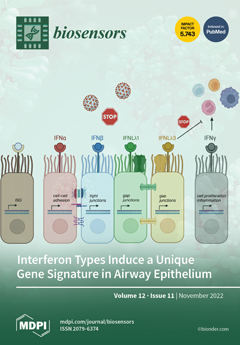Surface engineering of nanozymes has been recognized as a potent strategy to improve their catalytic activity and specificity. We synthesized polydopamine-coated Co
3O
4 nanoparticles (PDA@Co
3O
4 NPs) through simple dopamine-induced self-assembly and demonstrated that these NPs exhibit catalase-like activity
[...] Read more.
Surface engineering of nanozymes has been recognized as a potent strategy to improve their catalytic activity and specificity. We synthesized polydopamine-coated Co
3O
4 nanoparticles (PDA@Co
3O
4 NPs) through simple dopamine-induced self-assembly and demonstrated that these NPs exhibit catalase-like activity by decomposing H
2O
2 into oxygen and water. The activity of PDA@Co
3O
4 NPs was approximately fourfold higher than that of Co
3O
4 NPs without PDA, possibly due to the additional radical scavenging activity of the PDA shell. In addition, PDA@Co
3O
4 NPs were more stable than natural catalase under a wide range of pH, temperature, and storage time conditions. Upon the addition of a sample containing sulfide ion, the activity of PDA@Co
3O
4 NPs was significantly inhibited, possibly because of increased mass transfer limitations via the absorption of the sulfide ion on the PDA@Co
3O
4 NP surface, along with NP aggregation which reduced their surface area. The reduced catalase-like activity was used to determine the levels of sulfide ion by measuring the increased fluorescence of the oxidized terephthalic acid, generated from the added H
2O
2. Using this strategy, the target sulfide ion was sensitively determined to a lower limit of 4.3 µM and dynamic linear range of up to 200 µM. The fluorescence-based sulfide ion assay based on PDA@Co
3O
4 NPs was highly precise when applied to real tap water samples, validating its potential for conveniently monitoring toxic elements in the environment.
Full article






